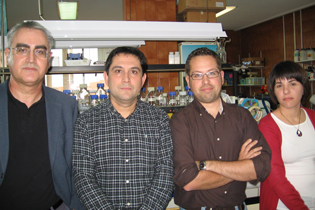Researchers from the Institute of Materials Science of Seville (cicCartuja, a joint centre of the Higher Council for Scientific Research-University of Seville) and the University of Malaga have developed a biodegradable material, derived from tomato skin, intended to cover the inside of cans of preserves.
According to the experts, it is an organic alternative that can replace the material that normally covers the inside of these containers to avoid contact with food or drink. This new coating, in addition to being environmentally friendly, maintains its properties in terms of durability and resistance.
In the article published in the Journal of Applied Polymer Science, the team of scientists summarises how they have developed a biodegradable material from vegetable cutin, a polymer that comes from tomato skin and can cover the inside of all types of containers used to preserve food or soft drinks.
“We looked at tomatoes because their skin has the same properties that these types of products require. That is, it is very resistant and does not melt, so it can withstand the sterilizing treatments that are normally applied to these cans,” explains the main person in charge of the project, José Jesús Benítez, researcher at the Institute of Materials Science of Seville, cicCartuja.
In this way, the experts have demonstrated the effectiveness of this new material both in soft drink or beer cans and in food packaging. “We can use it to package drinks, normally consumed in short periods of time, or to preserve food, since this can last several years until it reaches the consumer,” explains Benítez.
A patented product
To reach these conclusions, the experts first developed and patented the new material from tomato skin. “Before deciding to focus on tomatoes, we found that it is a very abundant product in Andalusia and that its skin does not melt, does not dissolve and is stable and homogeneous,” says Benítez.
He adds: “We extract the skin and, using laboratory techniques, we obtain a certain polyester chemically identical to the plant called cutin, which the plant uses as a skeleton of its external tissues to join its components and which is the key element that makes up the new product we have developed.”
Finally, once the new product was developed from plant cutin, the experts tested its effectiveness by applying it to metal sheets identical to those commonly used in packaging. “Finally, in the laboratory of the Institute of Materials Science in Seville, we demonstrated its usefulness as a protective material and interior coating both in short-life cans (aluminium sheet) and in more durable containers (steel and zinc alloy),” says the researcher.
Ecological packaging
In addition to being used as a coating for all types of packaging, this study, which gathers the experience of more than a decade of research on biodegradable components, has also allowed the experts to use plant cutin as a recyclable and ecological packaging material. “We have also demonstrated its ability to make bags or bottles that can be used on a daily basis and used as fertilizer when it is time to throw them away,” he says.
According to the experts, these data have allowed us to open lines of research with the aim of furthering the study of new organic materials from different types of fruit. “We are working on the idea of mechanically improving and perfecting the product, that is, using plant-based additives to make its structure more resistant and durable,” adds Benítez.
These results are the result of the national and excellence projects Obtaining Long-Chain Polyhydroxyalkanoate (PHA) Type Bioplastics from Commercial Fruit Epidermis Waste and Study of the Intermolecular Interactions between Long-Chain Hydroxycarboxylic Acids as a Model for the Design of Biomimetic Polyesters funded, respectively, by the Ministry of Economy, Innovation, Science and Employment of the Junta de Andalucía and the Ministry of Economy and Competitiveness.
Bibliographic reference:
J.J. Benítez, J.A. Heredia-Guerrero, S. Guzmán-Puyol, E. Domínguez and A. Heredia. (2014). ‘Polyester Films Obtained by Noncatalyzed Melt-Condensation Polymerization of Aleuritic (9,10,16-Trihydroxyhexadecanoic) Acid in Air’. Journal of Applied Polymer Science, DOI: 10.1002/app.41328.
Source: Fundación Descubre




